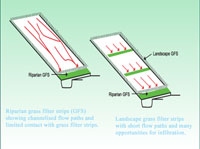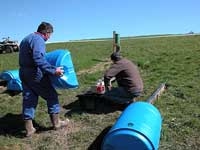Grass filter strip trials promising


Mac Pacey (farmer, left) and Colin Stace (EBoP Senior Land Management Officer) inspect filter strip tipping buckets. (Photo: Amy Taylor, EBoP)
Installing grass filter strips in the landscape could be a valuable practice as part of efforts to reduce sediment and nutrient runoff into the Rotorua Lakes.
Grass filter strips are most often located in riparian areas. In these situations, the performance of the filter strips may be compromised because of inundation, saturation, and channelised flow (where the runoff congregates in natural ‘channels’ reducing the opportunities for contact with the filter strips). Landscape grass filter strips, by contrast, are planted across paddocks, rather than just alongside watercourses.
We have planted grass filter strips in paddocks at two farms in the Rotorua area. We are trialling a strip of retired pasture (a mix of rye grass, white clover, and browntop), and a stiff stemmed grass species Phalaris aquatica.
Preliminary results suggest that the strips are capturing significant amounts of suspended sediment and total phosphorus: 40% in one storm event. The research is continuing and, given the encouraging results, we hope to integrate landscape grass filter strips into grazing systems, and compare filtering efficiencies with riparian strips.
This work is funded by MoRST and Environment Bay of Plenty.
